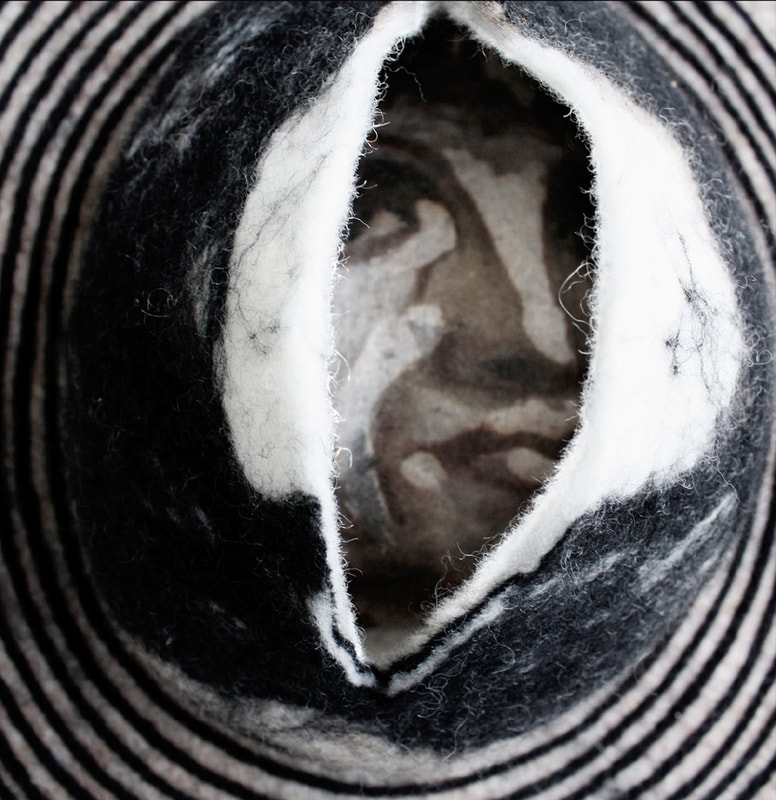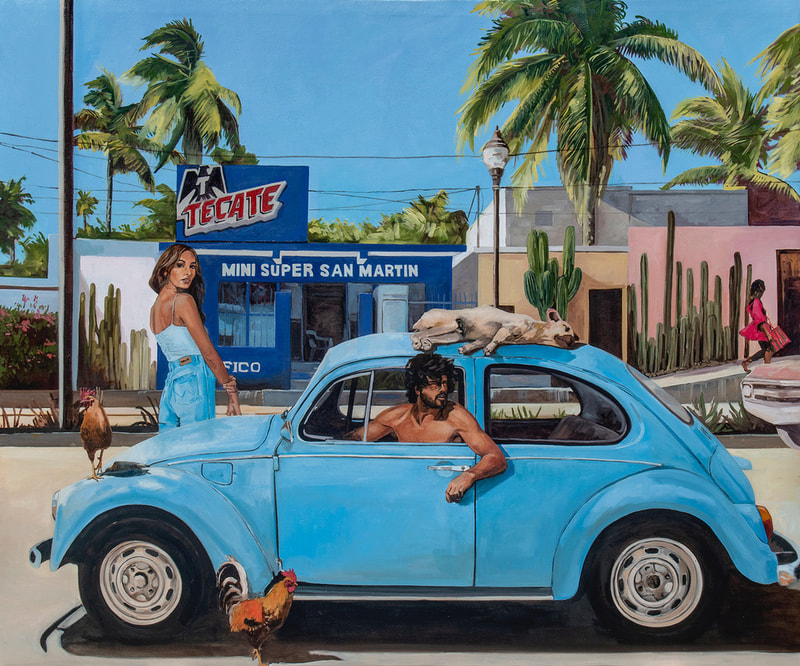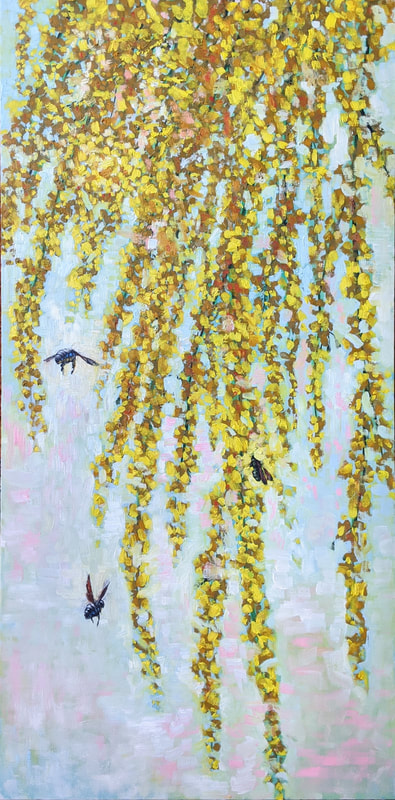Repercussions
IMAGE ABOVE: Detail of "Palo Verde with Carpenter Bee" by Christopher Vena
|
The Kruglak Gallery “Repercussions” is an invitational art exhibit that includes works of art from six artists. “Repercussions” will showcase a breadth of multimedia work representing unique perspectives. Accompanying their art is a statement from each artist about how the COVID-19 virus impacted their life as an artist.
At this moment, we are in a state of ongoing recovery; the novel coronavirus has caused much uncertainty. An invited artist who survived COVID-19 currently is sustaining bi-coastal teaching and art practice during a continued recovery. Others have returned to the new normal trying to juggle the maintenance of life, family, and work during a time when losses and questions abound. |
Participating Artist:
Naomi J. Falk Patrick 'Pato' Herbert Erika Osborne Valya Simpson Tracy Stuckey Christopher Vena |
Naomi J. Falk
Through happenstance, I came across Adrienne Rich’s poem, “What Kind of Times Are These” after beginning this cyanotype and sculpture series.
Allusion and urgency. Nameable, elusive.
“…picking mushrooms at the edge of dread…”
A pause, a breath, the space between…between here and there, between you and me, between what is said and what is heard, meant, or left unspoken.
“…this is not somewhere else but here…”
I have felt imprisoned, boxed in by the pandemic, by the virus, by my workload, by a stalled relationship slipping away, by your losses and mine. And, yet…
“…Because you still listen…”
Questions abound. What measures do each of us take to feel safe? How do we negotiate this world? These physical and psychological boundings? Where do we find our place?
“…ghost-ridden crossroads…”
Safety, care, respect, belonging. Inalienable rights. But, the world is not equal or just. And, so there is more work to do. Our paths intersect.
“…and the old revolutionary road breaks off into shadows…”
- Includes excerpts from “What Kind of Times Are These” by Adrienne Rich
Patrick 'Pato' Hebert
Lingering
I currently live in Los Angeles. California is home to more coronavirus cases than any other state in the USA. COVID-19 is the second leading cause of death in Los Angeles County.
I am what is commonly known as a COVID “long hauler.” I have been sick for over seven months. I still continue to experience weekly flare-ups — sore throat, short-term memory loss, waves of fatigue — even though my latest test result was negative. Last month I made a return visit to Urgent Care for a gastrointestinal exam. I also had a comprehensive pulmonary exam, and met with a neurologist. The impact of the virus lingers in my body and being. This is a frustrating process that I call the COVIDoldrums.
Maddeningly, the coronavirus also continues to spread more broadly, wreaking havoc in a horrifying process with no end in sight. I often refer to this historic moment as la COVIDa Loca — the crazy COVID life. Latinx people are disproportionately impacted across the United States. Here in California we comprise 55% of all COVID-19 cases.
When the mayor first closed the pools and gyms in March, I started walking in Elysian Park. This was also where I accessed one of the county’s COVID-19 testing sites on March 24. And the park is where I returned once I finally had enough energy to take my first gentle, 15-minute walk during my initial recovery in April. Since then, daily, two-mile walks in the park have become integral to my gradual healing process. These walks are a lifesaver. They slowly help to rebuild my lung capacity and strengthen my spirit. I walk and use my phone to make pictures.
LA’s raw, expansive Elysian Park offers the gift of images. Reminders of the pandemic are everywhere. The park is marked by people’s protection and affection, care and pleasure. I have been making pictures with my mobile phone during my daily walks. The images presence the virus’ impact on our lives, our impact on the park, and the persistence of the park’s land as a precious resource.
Elysian Park is a hilly beacon of 600 acres right in the heart of the city—free and accessible during daylight hours. Its trails, breezes and embrace are even more vital to the city’s wellness practices during the pandemic. It is a special place that has been invaluable to my own process of recovery and creativity.
For decades LA’s Elysian Park has been utilized by Latinx families, young people, elders, queer people as well as other immigrant communities. Jogging, dog walking and socially distanced picnics are just some of the activities that continue to proliferate. In the face of the coronavirus onslaught we practice multiple forms of care for self and others. This resilience ranges from mutual aid efforts to exercise.
Across contemporary media, I have found that too little has been written or created from the perspective of artists and people infected with the novel coronavirus, even as our ranks continue to grow by the thousands every day. Most of us are too tired and are just trying to survive. My Lingering images walk against this silence and evoke the masses of people navigating the strangeness and immense uncertainty of COVID-19.
I am what is commonly known as a COVID “long hauler.” I have been sick for over seven months. I still continue to experience weekly flare-ups — sore throat, short-term memory loss, waves of fatigue — even though my latest test result was negative. Last month I made a return visit to Urgent Care for a gastrointestinal exam. I also had a comprehensive pulmonary exam, and met with a neurologist. The impact of the virus lingers in my body and being. This is a frustrating process that I call the COVIDoldrums.
Maddeningly, the coronavirus also continues to spread more broadly, wreaking havoc in a horrifying process with no end in sight. I often refer to this historic moment as la COVIDa Loca — the crazy COVID life. Latinx people are disproportionately impacted across the United States. Here in California we comprise 55% of all COVID-19 cases.
When the mayor first closed the pools and gyms in March, I started walking in Elysian Park. This was also where I accessed one of the county’s COVID-19 testing sites on March 24. And the park is where I returned once I finally had enough energy to take my first gentle, 15-minute walk during my initial recovery in April. Since then, daily, two-mile walks in the park have become integral to my gradual healing process. These walks are a lifesaver. They slowly help to rebuild my lung capacity and strengthen my spirit. I walk and use my phone to make pictures.
LA’s raw, expansive Elysian Park offers the gift of images. Reminders of the pandemic are everywhere. The park is marked by people’s protection and affection, care and pleasure. I have been making pictures with my mobile phone during my daily walks. The images presence the virus’ impact on our lives, our impact on the park, and the persistence of the park’s land as a precious resource.
Elysian Park is a hilly beacon of 600 acres right in the heart of the city—free and accessible during daylight hours. Its trails, breezes and embrace are even more vital to the city’s wellness practices during the pandemic. It is a special place that has been invaluable to my own process of recovery and creativity.
For decades LA’s Elysian Park has been utilized by Latinx families, young people, elders, queer people as well as other immigrant communities. Jogging, dog walking and socially distanced picnics are just some of the activities that continue to proliferate. In the face of the coronavirus onslaught we practice multiple forms of care for self and others. This resilience ranges from mutual aid efforts to exercise.
Across contemporary media, I have found that too little has been written or created from the perspective of artists and people infected with the novel coronavirus, even as our ranks continue to grow by the thousands every day. Most of us are too tired and are just trying to survive. My Lingering images walk against this silence and evoke the masses of people navigating the strangeness and immense uncertainty of COVID-19.
You can read more about Pato Hebert's journey here.
Erika Osborne
What a year! It’s hard to believe I began 2020 in Mexico, on a Fulbright U.S. Scholar fellowship creating artwork about the relationship of culture to wildfire in the Sierra de la Laguna mountains of Baja California Sur. Of course, when March hit, in Mexico like everywhere else, COVID-19 was taking a toll. By mid-March, the Fulbright Foundation mandated the return of all U.S. Scholars from their host countries. In a matter of two weeks, I went from living the ideal – making art, doing research, and spending time on the beach in Baja California Sur - to living with family in Utah (our house in Colorado was still being rented) and homeschooling my kids.
Since then, life continues to be the catawampus. I am back teaching at Colorado State University in “the new normal” which means much more time on the computer than is probably healthy. My two young kids have been remote learning, which means my husband (who is also an artist and university professor) and I are constantly juggling our university workloads, our art practice, our kids' schooling, and of course the general upkeep of life.
This year has made me realize how precious studio time is. I NEED it. It grounds me and keeps me sane. It exercises my mind and my hand in necessary ways. Because my time in the studio is limited (a.k.a. hardly existent) any time I find to paint or draw has become sacred. As we exit this pandemic, whenever that might be, I hope I can hold onto that sacredness.
Valya Simpson
The alchemy of life inspires me. My recent artwork deals with the human hunger to know of one’s origins, the concept of identity, and the visual exploration of memory.
Maybe three years ago I've got a strong feeling that something is coming to hit us, humans. Something very powerful. I lost interest in doing art. I lost a sense of doing it. So I was not surprised nor was I scared when the pandemic arrived. I think we, as humans, are slowly waking up from the terrible dream we were in for so long. We are on the very edge of extinction. Now everything is pushing for changes and the art world too. Personally have plenty of time to contemplate my life and my art. I don't know what I will be doing next but I know that it will be very different from what I did before.
Tracy Stuckey
2020 started off as the second half of my family’s year in the Southern Baja California, Mexico, we had been there since August of 2019. We were there for my wife’s (also an artist) sabbatical. It was an amazing experience, we had a beautiful outdoor studio where we could take advantage of the tropical weather and we had immersed ourselves into the area and were trying to make work about our experiences. When COVID-19 hit the US, we were forced to leave Mexico and return home. We spent the first month and a half living with my in-laws in Utah while our home in Colorado became available. In Utah, we had very little time for work and no studio. Once back in Colorado, we adjusted our lives to the “new normal” of having our kids around and the limited mobility because of COVID-19.
I find being an artist to be a very solitary practice, I spend hours and hours in my studio tuned in to my work and process. It has been difficult to get time in the studio while juggling our kids’ homeschooling and now a busy semester teaching both online and in-person. The biggest adjustment in my artistic practice has simply been a lack of time and focus. Being an artist and professor who is married to another artist and professor has us both scrambling to find time in our studios. This new situation has forced me to be much more efficient with my time.
Except for some face coverings which I had in mind for a while now, no imagery or ideas about the pandemic have made their way into my paintings. Instead, I have been trying desperately to hold on to memories of my experiences in Mexico in order to complete the body of work I started in the fall of last year. We had such an abrupt end to our time and were then forced to adapt to a whole new way of life that I sometimes find it hard to remember. I am thankful for my overall health and wellbeing, but I hope for a little more time in my studio moving forward.
I find being an artist to be a very solitary practice, I spend hours and hours in my studio tuned in to my work and process. It has been difficult to get time in the studio while juggling our kids’ homeschooling and now a busy semester teaching both online and in-person. The biggest adjustment in my artistic practice has simply been a lack of time and focus. Being an artist and professor who is married to another artist and professor has us both scrambling to find time in our studios. This new situation has forced me to be much more efficient with my time.
Except for some face coverings which I had in mind for a while now, no imagery or ideas about the pandemic have made their way into my paintings. Instead, I have been trying desperately to hold on to memories of my experiences in Mexico in order to complete the body of work I started in the fall of last year. We had such an abrupt end to our time and were then forced to adapt to a whole new way of life that I sometimes find it hard to remember. I am thankful for my overall health and wellbeing, but I hope for a little more time in my studio moving forward.
Christopher Vena
The quarantine and the protests have affected me deeply. My wife continued to work but I lost my teaching job and was spending a lot of time alone, fighting depression. Painting helped me get through it but the sudden drastic changes made me rethink some things. I suddenly lost interest in painting the marches and protests I had been attending and photographing over the last seven years. I was trying to raise awareness with the earlier paintings but now that everyone was well aware, the idea of continuing in that vein felt exploitative. That, and I needed a break.
The lockdown made me long for the outdoors so I decided to paint my favorite local flora/fauna pair. They are unique to the Sonoran Desert. The exuberant annual blooming of the palo verdes deserves a reputation on par with the cherry blossoms of Japan or the fall leaves of New England. So do the huge, shiny, black, bees that pollinate them. Those were fun to paint. So were the two self-portraits. They were meant to be a record of my repetitive day to day experience and to give me something to do that I could finish in a night or two instead of a few weeks or months. But they seemed to resonate with people, especially those who were forced to live the same kind of life. It's still tough, but the quarantine has made me very productive if nothing else.
The lockdown made me long for the outdoors so I decided to paint my favorite local flora/fauna pair. They are unique to the Sonoran Desert. The exuberant annual blooming of the palo verdes deserves a reputation on par with the cherry blossoms of Japan or the fall leaves of New England. So do the huge, shiny, black, bees that pollinate them. Those were fun to paint. So were the two self-portraits. They were meant to be a record of my repetitive day to day experience and to give me something to do that I could finish in a night or two instead of a few weeks or months. But they seemed to resonate with people, especially those who were forced to live the same kind of life. It's still tough, but the quarantine has made me very productive if nothing else.






























